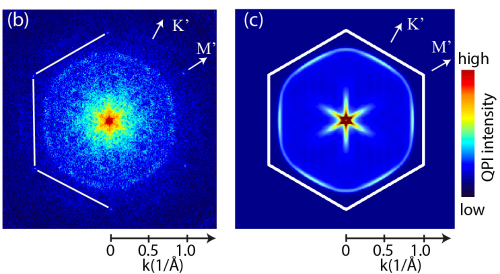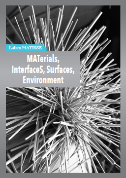Spin triplet states in 2D superconductors : theory and experiments
Axe 4 - Dimensionnalité et confinement
Post-doctorat de Cesare Tresca
Travail de recherche initié le 1er décembre 2017.
Laboratoires co-porteurs
- Institut des NanoSciences de Paris (INSP)
Porteur de projet : Matteo Calandra - L'Institut de Minéralogie, de Physique des Matériaux et de Cosmochimie (IMPMC)
Encadrants : Tristan Cren, Christophe Brun
Mots clés
Electronic Structure Calculations - Density functional theory - 2D materials -
Quasi particle interference - superconductivity - scanning tunneling spectroscopy -
Mott insulating states - relativistic effects
Résumé
Two-dimensional materials with spin-polarized surface states are promising candidates for spintronic applications. A first step in this direction, using strong Rashba spin-orbit coupling (SOC), has been made in some heavy-group atoms grown epitaxially on group IV surfaces, like β-Pb/Ge [Nat. Commun. 1, 17 (2010)] or Au/Si [Scie. Rep. 3, 1826 (2013)].
Surprisingly, in less dense 1/3 monolayer (ML) phases, until today in most studies the effects produced by SOC were overlooked while reversible phase transitions as a function of temperature were found [Nature 381, 398 (1996)], accompanied by magnetic orderings [Nat. Commun. 4, 1620 (2013), PRL 111, 106403 (2013)], metal-insulator transitions [PRL 96, 126103 (2006)] and also superconductivity [Nature Phys. 6, 104 (2010)]. Depending on the coverage and the substrate there are many possible reconstructions and related physical properties.
In these materials any tiny changes in coverage or substrate can determine completely different physical properties. Thus the study of these materials represent a topic of great interest for the variety of compounds, structures and characteristics they could exhibit.
In a recent work Verbitskiy and collaborators [2D Materials 3, 4 (2016)] studied a novel Ba decored graphene phase with BaC8 stoichiometry giving the experimental possibility to extend previous topics on graphene substrate.
To this arguments are related a lot of very interesting applications opening the way to the concrete possibility to explore novel exotic physical properties and also to develop new twodimensional spintronic devices, possibly using a well known technology such as the silicon (or graphene) one.
The present project will focus on a computational study of the structural, electronic, magnetic and possibly superconducting properties of heavy atoms on different substrates. The research will be strongly supported by experiments, in particular by scanning tunneling microscopy/spectroscopy (STM/STS).
Furthermore we are going to develop a theoretical tool to evaluate by first principles the quasiparticle interference (QPI) [Phys. Rev. B 57, R6858 (1998)] that can be measured by performing the Fourier transform of the the STS map [Applied Phys., 44, 464010 (2011)] (see Fig.1).

Fig.1: measured (b) and calculated (c) QPI map for 1/3ML Pb/Si(111).
Publication
- Cesare Tresca, Matteo Calandra
Charge density wave and spin 1/2 insulating state in single layer 1T-NbS2
IOP Science, 2D Materials, Volume 6, Number 3, 2019
DOI : 10.1088/2053-1583/ab23c0 - C. Tresca, C. Brun, T. Bilgeri, G. Menard, V. Cherkez et al.
Chiral Spin Texture in the Charge-Density-Wave Phase of the Correlated Metallic Pb / Si ( 111 ) Monolayer
Physical Review Letters, American Physical Society, 2018, 120 (19), pp.196402.
DOI : 10.1103/PhysRevLett.120.196402
Ref HAL : hal-01792155v1 - Boris V. Senkovskiy, Dmitry Yu. Usachov, Alexander V. Fedorov, Tomas Marangoni, Danny Haberer, Cesare Tresca et al.
Boron-Doped Graphene Nanoribbons: Electronic Structure and Raman Fingerprint
ACS Nano, 2018, 12 (8), pp 7571–7582
DOI: 10.1021/acsnano.8b04125 - Cesare Tresca1,2,3, Nikolay I. Verbitskiy4,5,6, Alexander Grüneis5 and Gianni Profeta
Ab initio study of the (2 × 2) phase of barium on graphene
Eur. Phys. J. B (2018) 91: 165
DOI : 10.1140/epjb/e2018-90141-6
Autres
[publication] une récente publication de Cesare Tresca reprise dans Les Faits d'Actu de l'INSP. Un travail de recherche de l'axe 4 du @LabexMatisse : Dimensionnalité et confinement https://t.co/rgBL5AZSg9@INP_CNRS @INC_CNRS
— Labex MATISSE (@LabexMatisse) October 26, 2018
Egalement dans la rubrique
- Bords et défauts de matériaux 2D : nano-spectroscopie TERS
- Etude des propriétés mécaniques et de l’adhésion des couches minces intervenant dans les verres ophtalmiques d’Essilor
- Etude du transport électronique et excitonique dans des hétérostructures de van der Walls MoS2/WSe2
- Exaltation de l’anisotropie magnétique dans des nano-composites autoassemblés en épitaxie verticale.
- Nanoparticules d’or pour l’électronique à une charge
- Spectroscopie optique de boîtes quantiques GaAs/AlGaAs de nouvelle génération sous champ magnétique
- Theoretical modeling of electrochemically-doped superconducting nanolayers
MATISSE en chiffres
- 4 disciplines : Chimie, Physique, Sciences de la Terre, Patrimoine
- 400 permanents
Contact
Direction
Florence Babonneau
Administration
Communication
Emmanuel Sautjeau



